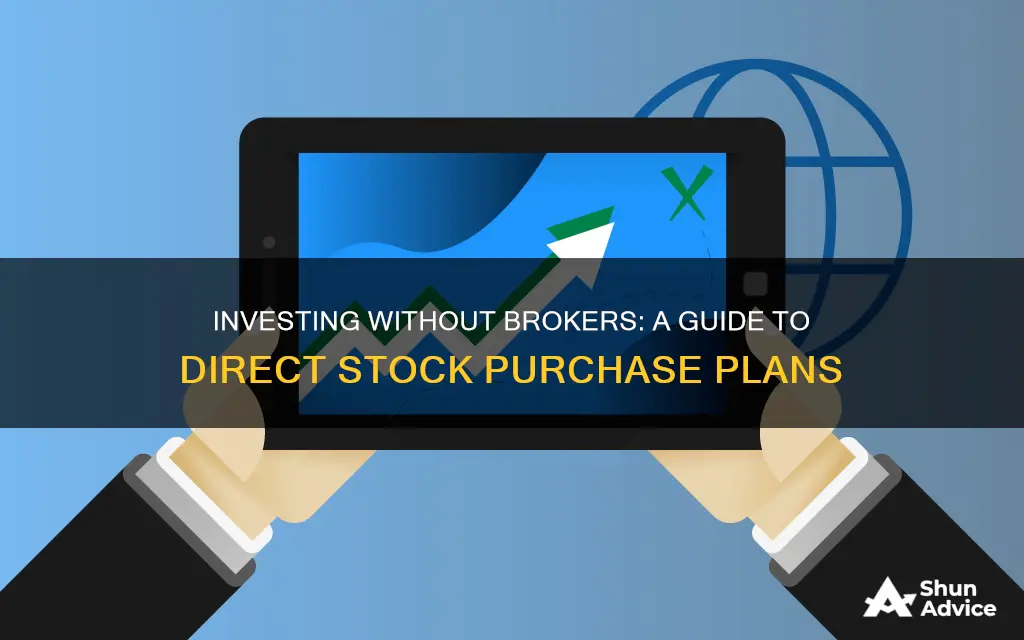
Investing in stocks without a broker is possible and can be done in a few different ways. While a broker can offer trading advice and personalised investment strategies, they can also be costly. Using a broker-dealer platform, you can take part in self-directed trading and avoid hefty brokerage fees.
There are three main options for buying stocks without a broker:
- Direct Stock Purchase Plans (DSPPs)
- Dividend Reinvestment Plans (DRiPs)
- Online Brokerage Accounts
DSPPs allow investors to purchase shares directly from the company itself, with the help of a transfer agent. DRiPs are similar, but also allow investors to reinvest dividends to purchase more stock. Online brokerage accounts are another option, offering convenience, lower fees, and the ability to customise investment strategies.
| Characteristics | Values |
|---|---|
| How to buy stocks without a broker | Via online brokerage accounts, dividend reinvestment plans, and direct stock purchase plans |
| Full-service brokers | Offer trading advice, personalized investment strategies, and additional services |
| Direct stock purchase plans | Allow investors to buy shares directly from the company |
| Dividend reinvestment plans | Reinvest dividends to purchase more stock |
| Online brokerage accounts | Offer convenience, lower fees, and the ability to customize investment strategies |
| Self-directed trading | Possible via broker-dealer platforms |
| Types of trading accounts | Online brokerage platforms, direct stock purchase plans, dividend reinvestment accounts |
| Steps to self-directed trading | Determine the type of trading account, research companies, determine budget and pick a stock, buy stock |
| Benefits of direct stock purchase plans | No brokerage fees, discounts offered by companies |
| Drawbacks of direct stock purchase plans | Lack of flexibility, higher upfront costs, long-term investments |
| Benefits of dividend reinvestment plans | Automated, compounded growth, fee-free reinvestment, fractional shares |
| Drawbacks of dividend reinvestment plans | Limited selection, taxable dividends |
| Online brokerage accounts | Low or no fees, DIY investing, on-demand investing |
| Drawbacks of online brokerage accounts | Investor is on their own, long-term investments |
What You'll Learn

Direct Stock Purchase Plans (DSPPs)
Some companies that offer DSPPs make the plans directly available to retail investors, while others use transfer agents or third-party administrators to handle these transactions. Examples of companies that offer DSPPs include Walmart, Starbucks, and Coca-Cola. DSPPs are ideal for investors who want to start investing in small amounts, as some companies allow fractional share purchases.
DSPPs offer low fees and sometimes the ability to purchase shares at a discount. Some DSPPs have no fees, but most have small fees. These fees could include initial investment fees, purchase fees, administrative fees, selling fees, and transfer fees. DSPPs are best for long-term investors, as shares are illiquid and are difficult to re-sell without using a broker.
The main benefits of DSPPs are the cost savings from eliminating broker fees, the potential for companies to offer discounts, and the simplified purchasing experience. DSPPs also promote stronger investor relations, as the company can reach out to investors directly, and prevent short-selling, which reduces price volatility.
However, there are also drawbacks to DSPPs. While brokerage fees are eliminated, there may be other fees, such as account setup fees, transaction fees, or fees to sell. DSPPs also reduce portfolio diversity and limit trading options, as the investor is limited to one stock. It is also difficult to know the price of each share before purchasing, as the prices are an average, which makes it more complicated for investors to sell.
Fidelity Branches: Can You Deposit Cash?
You may want to see also

Dividend Reinvestment Plans (DRiPs)
There are two main types of DRiPs: brokerage account plans and company DRiPs. With a brokerage account plan, investors can access multiple investment types, such as individual stocks, mutual funds, and ETFs, all from a single account. This makes it easier to diversify holdings. Many brokers also allow investors to reinvest dividends, rather than receiving them as payouts.
Company DRiPs, on the other hand, are solely for investors who want to invest in individual stocks and one specific stock at a time. This limits the ability to invest in other options, such as mutual funds or exchange-traded funds. However, companies may offer their stock at a discount to the market price, and some don't charge commissions or fees to enroll or buy shares.
DRiPs offer several advantages, including automated and compounded growth, fee-free reinvestment, and the ability to buy fractional shares. However, there are also some disadvantages, such as a limited selection of companies offering DRiPs and the fact that dividends are still taxable.
Ultimately, DRiPs can be a powerful way to boost returns over the long term, but it's important to consider the pros and cons before deciding if this strategy is suitable for your investment goals.
Cashing Out Refinance: A Smart Investment Move?
You may want to see also

Online Brokerage Accounts
Pros
- Lower fees: Online brokerage accounts often have lower fees compared to full-service brokers, and many online firms do not charge commissions.
- DIY investing: Online brokerage accounts offer a lot of freedom and flexibility, allowing investors to create customised investment plans.
- On-demand investing: Investors can make trades whenever the markets are open, providing easy access to buying and selling.
Cons
- Self-directed: While this can be a benefit for those who want freedom, it may be a con for those who feel overwhelmed by the idea of having to research and form a strategy on their own.
- Long-term focus: The on-demand nature of online investing means investors can sell whenever they like, which may be challenging for those who lack patience or are prone to impulsive decisions.
Examples of Online Brokerage Firms
- Fidelity
- Charles Schwab
- Robinhood
- Webull
- J.P. Morgan Self-Directed Investing
- ETRADE
- Interactive Brokers
- Public
- Ally Invest
- Firstrade
Temporary Investments: Are They Really Cash?
You may want to see also

Self-Directed Trading
Technically, you cannot buy stocks without a broker, but you can take part in self-directed trading by using a broker-dealer platform. This allows you to avoid paying brokerage fees while still participating in the stock market.
Step 1: Determine the type of trading account you want to use
First, decide on the type of investment account you would like to use. If you want access to tools and resources to help you navigate your investments, consider using an online brokerage platform. Once you've selected an option, set up your account and transfer money from your bank account so you can start investing.
Step 2: Research the companies you want to purchase stocks from
Take time to research and read about the different stocks you're interested in, including recent business press releases and letters to shareholders. This can be overwhelming for those without financial expertise, but there are resources available to help.
Step 3: Determine your budget and pick a stock
If you plan to invest in multiple companies, decide how much of your budget you want to allocate to each. This will help you understand how much stock you can afford to buy from each company. Keep in mind that some companies, especially if you use an online broker, will allow you to buy fractions of stock, which can be a great option for companies with high stock prices.
Once you've determined your budget, it's time to pick a stock. Successful traders use stock screeners to help find patterns and make data-driven decisions. Some important pieces of data to consider include trade index volume, peer-to-peer company strengths, market news and opinions, liquidity, and volatility.
Step 4: Buy your stock
When you know what and how much you want to buy, it's time to make your purchase. If you use an online brokerage, you can typically track your investment using a single platform and stay updated on the company's communications.
There are two main types of orders: market orders and limit orders. Market orders are filled right away at the currently listed price, but prices can change within seconds, so attention is required. Limit orders are filled when the price reaches a certain point and can be useful if you want to buy a stock at a discount. Limit orders expire after a certain amount of time and do not guarantee a specific execution price.
There are three main methods for buying stocks as a self-directed investor:
Method 1: Buying Directly From The Company
This is known as a direct stock purchase plan (DSPP) or direct investment plan. You need to know exactly which companies you want to invest in and then determine the protocols for buying shares through their platform. DSPPs have the benefit of no brokerage fees, and companies sometimes offer discounts for direct purchases. However, a major drawback is the lack of flexibility, as you can't manage investments from multiple companies on a single platform, and buying and selling stocks can be a slower process.
Method 2: Opening A Dividend Reinvestment Account
A dividend reinvestment plan (DRiP) can help you build your investment accounts passively. With these accounts, you buy stock directly from the companies, and any dividends you earn are automatically reinvested to purchase more stock. This method can be good for those who want to hold onto a company's stock for an extended period. However, not all companies that offer DSPPs also provide DRiPs, so your options are more limited.
Method 3: Using An Online Brokerage Account
An online brokerage account is a good choice for those who want to buy stocks without a traditional broker. These accounts are straightforward to set up, similar to opening a bank account. They allow you to buy stock in a variety of companies and monitor, buy, and sell them from a single source. Many online firms have eliminated commissions, and you can access investing resources and trading apps without paying extra. However, some may find the level of choice and freedom overwhelming, and the lack of access to qualified financial professionals stressful.
Cash Outflow for Land Purchase: Investing Activity?
You may want to see also

Dollar-Cost Averaging (DCA)
DCA involves investing a predetermined, fixed amount of money in a target security at regular intervals over a certain period of time, regardless of price. This strategy eliminates the need to time the market and can reduce the average cost per share, thus lowering the total average cost per share of the investment.
For example, an investor using DCA decides on two parameters: the fixed amount of money to invest each time and how often the funds are invested. No further decisions are made about the timing or level of future investments. This lends itself to an automatic investment system, such as a payroll deduction or scheduled bank transfer.
The benefits of DCA include reduced investment risk, capital preservation, and the potential for higher returns in a declining market. It also helps investors avoid the disadvantage of lump-sum investing, where a security's price may be artificially inflated due to market sentiment.
However, there are some criticisms of DCA. One is that by purchasing securities in small amounts over a certain period, investors may incur high transaction costs, potentially offsetting the gains in their portfolio. Another is that DCA may not be suitable for investors seeking to realign their portfolios to protect against loss and take advantage of new opportunities in changing economic and physical environments. Finally, the DCA strategy may result in lower returns due to its focus on reducing risk.
Creating Cash Flow: Investment Strategies for Success
You may want to see also
Frequently asked questions
You can buy stocks without a broker by using an online brokerage account, a dividend reinvestment plan, or a direct stock purchase plan.
Full-service brokers offer a range of services and investment products, but they can be expensive. Discount and online brokers charge small commissions and do not offer investment advice.
DSPPs allow you to purchase shares of stock directly from a company with the help of a transfer agent. DSPPs are also known as no-load stocks.
A DRIP allows you to reinvest your dividends to purchase additional stock. Many companies that offer DSPPs also offer DRIPs.
Benefits include no commission fees, automated investing, and the ability to purchase fractional shares. Drawbacks include potentially high fees, lack of diversification, and cumbersome record-keeping for tax purposes.







